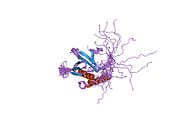STAP1
Signal-transducing adaptor protein 1 is a protein that in humans is encoded by the STAP1 gene.[5][6][7]
Function[]
The protein encoded by this gene functions as a docking protein acting downstream of Tec tyrosine kinase in B cell antigen receptor signaling. The protein is directly phosphorylated by Tec in vitro where it participates in a positive feedback loop, increasing Tec activity. A mouse ortholog, stem cell adaptor protein 1, shares 83% identity with its human counterpart.[7]
Interactions[]
STAP1 has been shown to interact with C19orf2.[8]
References[]
- ^ a b c GRCh38: Ensembl release 89: ENSG00000035720 - Ensembl, May 2017
- ^ a b c GRCm38: Ensembl release 89: ENSMUSG00000029254 - Ensembl, May 2017
- ^ "Human PubMed Reference:". National Center for Biotechnology Information, U.S. National Library of Medicine.
- ^ "Mouse PubMed Reference:". National Center for Biotechnology Information, U.S. National Library of Medicine.
- ^ Ohya K, Kajigaya S, Kitanaka A, Yoshida K, Miyazato A, Yamashita Y, Yamanaka T, Ikeda U, Shimada K, Ozawa K, Mano H (Nov 1999). "Molecular cloning of a docking protein, BRDG1, that acts downstream of the Tec tyrosine kinase". Proc Natl Acad Sci U S A. 96 (21): 11976–81. Bibcode:1999PNAS...9611976O. doi:10.1073/pnas.96.21.11976. PMC 18397. PMID 10518561.
- ^ Masuhara M, Nagao K, Nishikawa M, Sasaki M, Yoshimura A, Osawa M (Mar 2000). "Molecular cloning of murine STAP-1, the stem-cell-specific adaptor protein containing PH and SH2 domains". Biochem Biophys Res Commun. 268 (3): 697–703. doi:10.1006/bbrc.2000.2223. PMID 10679268.
- ^ a b "Entrez Gene: BRDG1 BCR downstream signaling 1".
- ^ Gstaiger M, Luke B, Hess D, Oakeley EJ, Wirbelauer C, Blondel M, Vigneron M, Peter M, Krek W (Nov 2003). "Control of nutrient-sensitive transcription programs by the unconventional prefoldin URI". Science. 302 (5648): 1208–12. Bibcode:2003Sci...302.1208G. doi:10.1126/science.1088401. PMID 14615539. S2CID 26836888.
Further reading[]
- Kurosaki T (1999). "Genetic analysis of B cell antigen receptor signaling". Annu. Rev. Immunol. 17 (1): 555–92. doi:10.1146/annurev.immunol.17.1.555. PMID 10358768.
- Harrington JJ, Sherf B, Rundlett S, Jackson PD, Perry R, Cain S, Leventhal C, Thornton M, Ramachandran R, Whittington J, Lerner L, Costanzo D, McElligott K, Boozer S, Mays R, Smith E, Veloso N, Klika A, Hess J, Cothren K, Lo K, Offenbacher J, Danzig J, Ducar M (2001). "Creation of genome-wide protein expression libraries using random activation of gene expression". Nat. Biotechnol. 19 (5): 440–5. doi:10.1038/88107. PMID 11329013. S2CID 25064683.
- Yokohari K, Yamashita Y, Okada S, Ohya K, Oda S, Hatano M, Mano H, Hirasawa H, Tokuhisa T (2002). "Isoform-dependent interaction of BRDG1 with Tec kinase". Biochem. Biophys. Res. Commun. 289 (2): 414–20. doi:10.1006/bbrc.2001.6008. PMID 11716489.
- Minoguchi M, Minoguchi S, Aki D, Joo A, Yamamoto T, Yumioka T, Matsuda T, Yoshimura A (2003). "STAP-2/BKS, an adaptor/docking protein, modulates STAT3 activation in acute-phase response through its YXXQ motif". J. Biol. Chem. 278 (13): 11182–9. doi:10.1074/jbc.M211230200. PMID 12540842.
- Ma J, Dempsey AA, Stamatiou D, Marshall KW, Liew CC (2007). "Identifying leukocyte gene expression patterns associated with plasma lipid levels in human subjects". Atherosclerosis. 191 (1): 63–72. doi:10.1016/j.atherosclerosis.2006.05.032. PMID 16806233.
- Beausoleil SA, Villén J, Gerber SA, Rush J, Gygi SP (2006). "A probability-based approach for high-throughput protein phosphorylation analysis and site localization". Nat. Biotechnol. 24 (10): 1285–92. doi:10.1038/nbt1240. PMID 16964243. S2CID 14294292.
Categories:
- Genes on human chromosome 4
- Human chromosome 4 gene stubs





